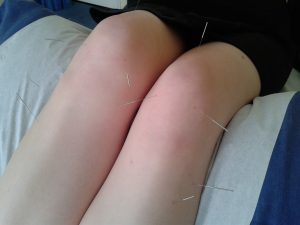The knee is the most complex joint in humans. It is also one of the joints that has to support our full body weight. Our bodies have several mechanisms to help support it, not least of which the muscle tone in the thighs which helps to keep all the intricate parts of this joint in place.
Knee pain can result from many different causes. There may be damage to the ligaments that hold the other tissues of the knee in place. Or there may be damage to the local muscles. Muscle damage resulting from over-exertion is referred to as a strain; whereas ligament damage is referred to as a sprain.
Covering the lower surface of the bone in the thigh and the upper surface of the bone in the leg that articulates with it are cartilage and menisci. These can also be damaged, which can cause knee pain or weakness or symptoms such as the knee locking. Permanent loss of cartilage is referred to as osteoarthritis and is common and can result from wear-and-tear as we grow older. This can in turn cause inflammation, which increases the symptoms of knee pain.


Major injuries to the knee ligaments, that involve tears to ligaments such as the anterior or posterior cruciate ligaments frequently require surgical procedure. Injuries to the medial collateral and lateral collateral ligaments normally do not necessitate surgery but can be painful and inhibiting and take a long time to heal.
In a large-scale series of clinical trials in Germany that were set up in 2001 and published in 2006, the results showed acupuncture for knee pain was beneficial for people suffering from osteoarthritis of the knee. As a result, health insurance companies were required by federal law to meet the costs of acupuncture for knee pain resulting from osteoarthritis. Jensen et al carried out a clinical trial in Norway in 1999 and also found acupuncture to be a viable form of treatment for patellofemoral knee pain syndrome.





